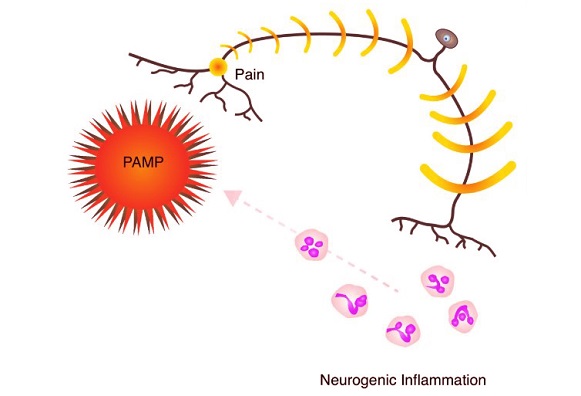Nikhil Prasad Fact checked by:Thailand Medical News Team Apr 24, 2025 2 hours, 21 minutes ago
Medical News: Pathogens Are Not Just Making You Sick They Are Controlling Your Pain Too
In a groundbreaking perspective published by researchers from the University of Pittsburgh Medical Center, Arizona State University, and the University of New Mexico, the idea of pain being a simple symptom of disease is being redefined. The study unveils a startling truth—many viruses, parasites, and bacteria have evolved to manipulate the human pain system for their own benefit.
 Peripheral nociceptors detect pathogen-associated molecular patterns (PAMP). Antidromic axon potentials then release neuropeptides, including substance P and calcitonin gene-related peptide, that initiate downstream inflammation and provide a host defense against bacterial and fungal pathogens.
Peripheral nociceptors detect pathogen-associated molecular patterns (PAMP). Antidromic axon potentials then release neuropeptides, including substance P and calcitonin gene-related peptide, that initiate downstream inflammation and provide a host defense against bacterial and fungal pathogens.
Pain is not just a signal that something is wrong. It is a powerful defense mechanism shaped by millions of years of evolution. This
Medical News report explores how pain systems and the immune system are deeply interconnected, working together to detect infections and injuries. However, this intricate neuroimmune network can be hijacked. Pathogens have learned to either shut down pain to stay undetected or amplify it to manipulate host behavior in ways that benefit their own survival.
How Pain Helps the Body Fight Infections
Sensory neurons responsible for pain, also called nociceptors, can detect bacterial toxins and trigger immune responses before any signs of illness appear. For instance, a class of neurons called TRPV1 detects harmful pathogens like Salmonella enterica, leading to immune responses that limit infection. These neurons also detect fungal and bacterial invaders and stimulate the release of peptides like CGRP and substance P, which help immune cells act quickly.
This pain-immune system synergy creates what scientists call "anticipatory immunity"—a sort of early warning system designed to limit the spread of infection. For example, when certain pain receptors in the skin are activated, they not only signal discomfort but also help defend nearby tissues against further microbial invasion.
Pathogens That Silence Pain and Trick the Immune System
While this system is powerful, some organisms have evolved ways to silence it. Toxoplasma gondii, a parasite known for altering rodent behavior, has also been shown to suppress gut pain in mice by triggering opioid receptors. Bacteria like Escherichia coli can produce toxins that interfere with opioid receptor pathways, reducing the pain normally caused by inflammation. Others like Mycobacterium ulcerans and Mycobacterium leprae physically damage pain-sensing nerves, making infections painless and harder to detect early.
Even the SARS-CoV-2 virus was found to temporarily suppress pain through a mechanism involving the VEGF-A/NRP-1 pathway. Researchers speculate this may allow the virus to build up inside the host while staying under the immune system’s radar.
Pathogens That Amplify Pain to Their Advantage
Not all infections silence pain—some amplify it. Staphylococcus aureus produces a toxin that causes severe pain while also impairing bacterial clearance. Similarly, Streptococcus pyogenes secretes a toxin that triggers pain-enhancing neuropeptides like CGRP, which ironically help the bacteria avoid immune attacks.
Parasites like Dracunculus medinensis manipulate pain in another unique way. The intense burning pain caused when this worm exits the skin forces infected individuals to immerse the affected limb in water, a behavior that aids the parasite’s reproductive cycle.
Chronic Pain Might Be an Evolutionary Defense
Chronic pain, often seen as a malfunction, might actually be an adaptive response. According to the researchers, heightened pain sensitivity during times of increased infection risk could serve as a proactive defense. This “smoke detector principle” suggests that a few false alarms (pain without real danger) are worth it if they help the body avoid major threats.
The brain may even be wired to anticipate pathogen manipulation. Pain plasticity—or the brain’s ability to adjust how pain is processed—might be one way our species counters pathogen tricks.
Implications for Pain Management and Treatment
Understanding how microbes manipulate pain could revolutionize how we treat chronic pain and infections. It explains why opioids, while effective at blocking pain, can suppress immune functions and lead to higher infection rates. It also opens the door to safer alternatives like probiotics or TRPV1-targeting compounds, which might relieve pain while boosting the body’s defenses.
Vaccines that target certain viruses, such as the shingles-causing varicella-zoster virus, already help prevent chronic pain syndromes. The findings also suggest that restoring healthy gut bacteria—disrupted by opioids—might help prevent pain sensitization and opioid tolerance.
Conclusion
This study reshapes our understanding of pain not as a one-way alarm system but as a dynamic battleground in an evolutionary war between humans and microbes. By manipulating our pain response, pathogens can hide, thrive, or spread. But humans too have evolved countermeasures, including the ability to recalibrate pain sensitivity. These insights could lead to new ways to prevent and treat chronic pain—by looking not just at the nerves but at the pathogens behind them.
The study findings were published in the peer reviewed journal: Evolutionary Applications.
https://onlinelibrary.wiley.com/doi/10.1111/eva.70098
For the latest COVID-19 News, keep on logging to Thailand
Medical News.
Read Also:
https://www.thailandmedical.news/news/dietary-supplements-emerge-as-possible-relief-for-long-covid-pain-sufferers
https://www.thailandmedical.news/news/the-impact-of-aging-and-hormonal-changes-on-chronic-pain
https://www.thailandmedical.news/news/dysfunctional-insulin-receptor-signaling-system-found-to-play-key-role-in-chronic-pain-and-diabetes-in-long-covid-patients
https://www.thailandmedical.news/pages/thailand_doctors_listings
